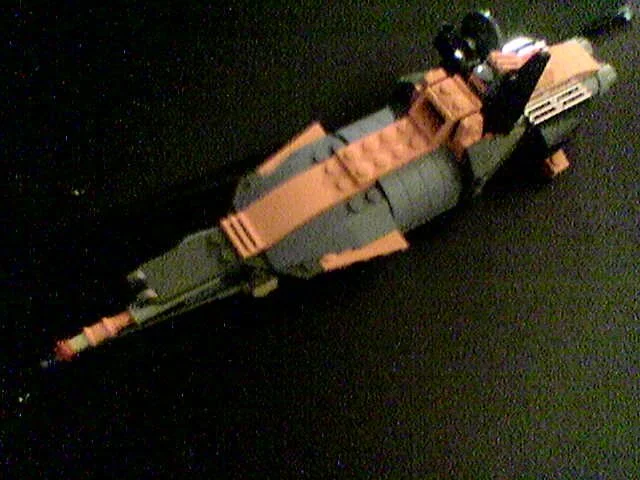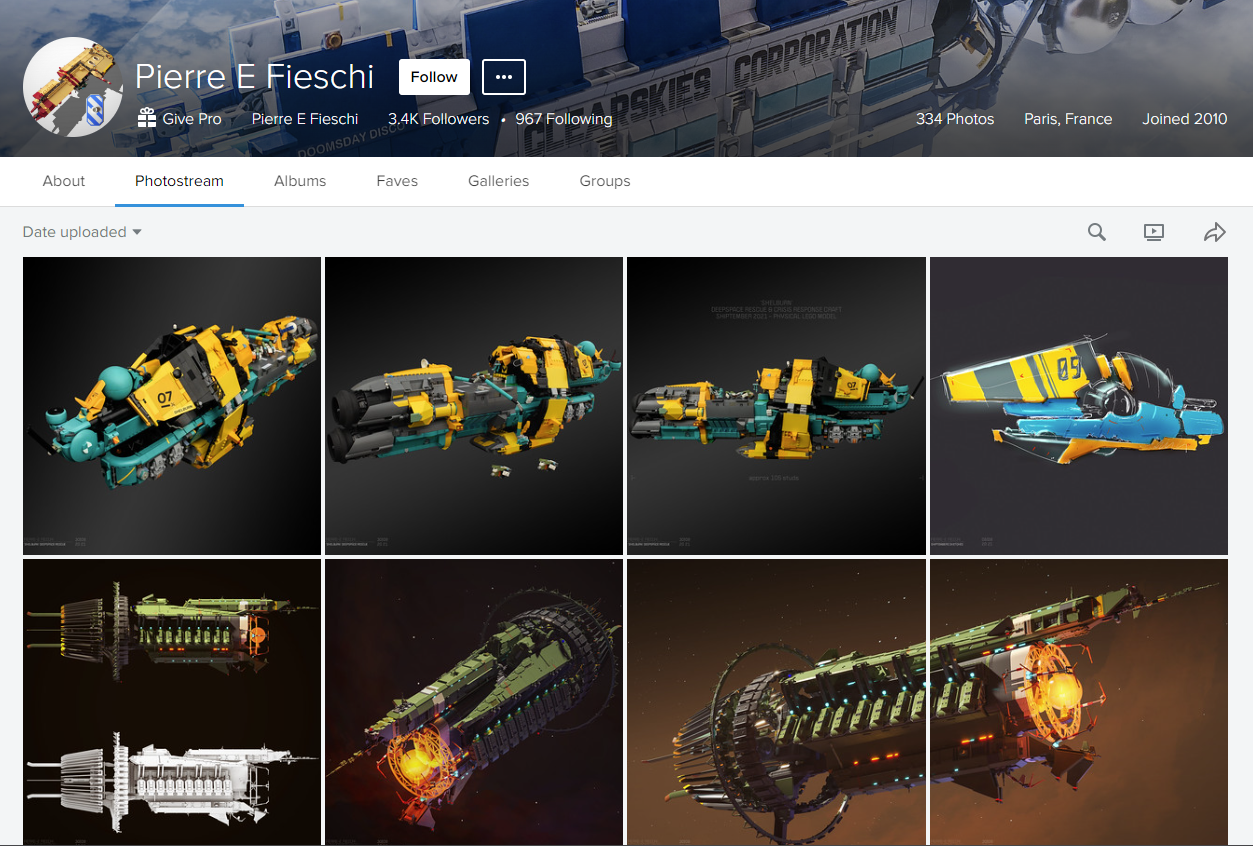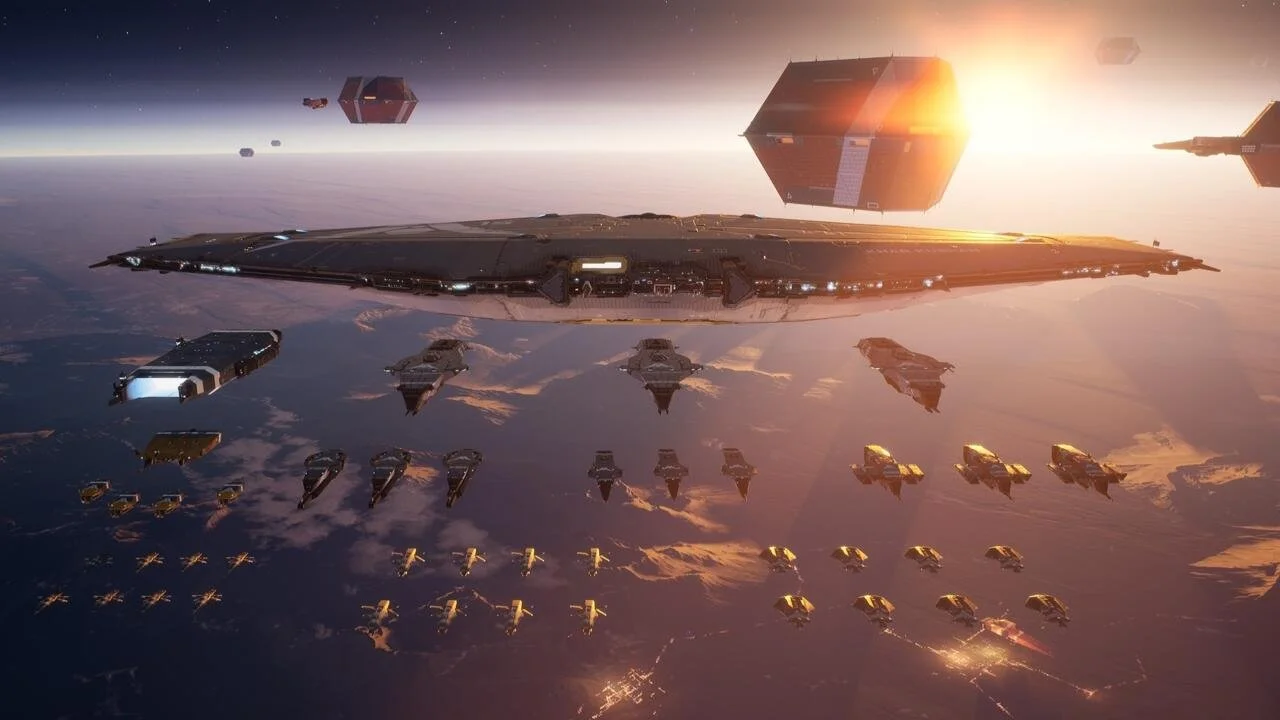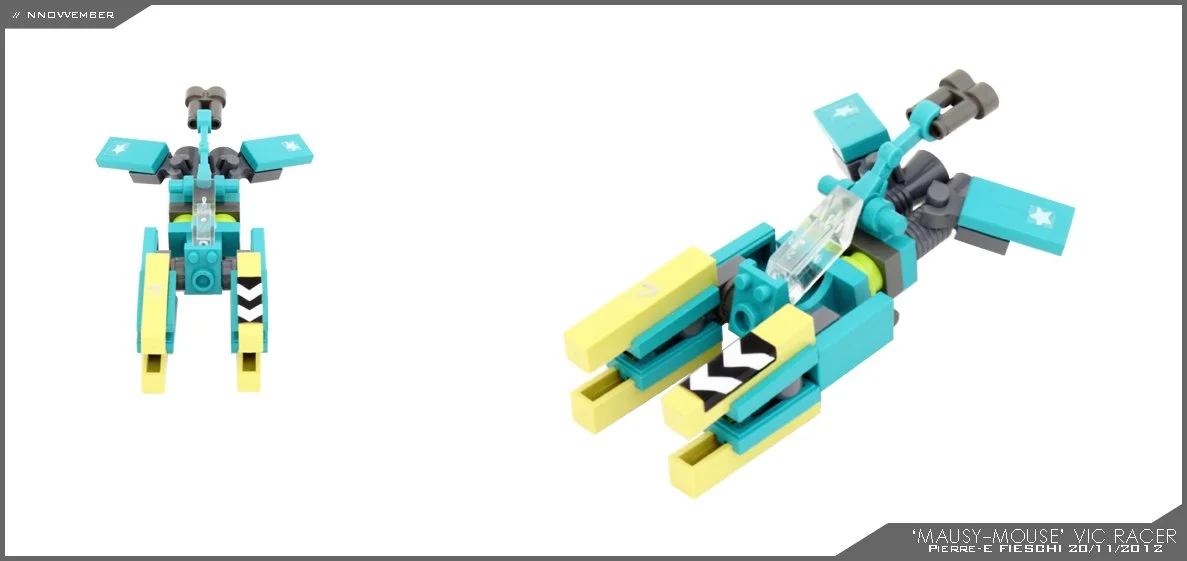Highlighting Uniqueness: A Chat with Pierre E Fieschi on Design and Creativity
/I joined Flickr in 2011 when I was 34 years old. A small midlife crisis was beginning to creep up on me. and I had been secretly looking at LEGO MOCs online for a couple of years. I still hadn’t accepted/realized that I was an AFOL and that LEGO was the creative outlet I needed in my life. Discovering the MOCs of Pierre E Fieschi was actually one of the turning points.
I saw his spaceships and rovers and I just thought to myself, “I NEED to do this!” I felt that I had to learn how LEGO works and start creating awesome stuff like him. 12 years later, I’m still learning but I have Pierre to thank for tipping me over the edge. I often return to his designs and try to analyze what makes them so good.
Joining BrickNerd as a contributor gave me an excuse to interview one of my personal “LEGO legends”. So I contacted Pierre and asked him some questions about LEGO, creativity, design and game development!
Introduction
Oscar: Tell me a little bit about yourself. Who are you, how old are you and what do you do for a living?
Pierre: My name is Pierre-Emmanuel Fieschi, I am 35 years old, a former architect, and founder of Renderstorm, a studio creating concept art and designs for the entertainment industry. I live near Vernon in Normandie France, pretty much in the middle of nowhere, and value having a lot of nature around.
Oscar: Were you introduced to LEGO as a child or what is your relationship to it?
Pierre: I was introduced to LEGO when I was 4, through my older sisters who had a few sets. I remember the day very precisely, including my first tablescrap. We had two of those red LEGO cardboard boxes (which I still have in my studio). I remember very well fiddling with the bricks of the 8660 Technic Arctic Rescue Unit, as well as the 269 ‘Kitchen’ set.
Oscar: How long have you been an AFOL and what inspired you to start building again?
Pierre: My Dark Age wasn’t very long or dramatic. The last set I remember buying as a teen was probably the 2002 Republic Gunship or Life on Mars Aero Tube Hangar. While I wasn’t really building anything in the following years, I kept a close eye on what LEGO was releasing and what people were building online.
My Dark age ended quickly after in 2004 with the release of the Titan XP set. The amount of dark blueish gray, orange, and sand blue elements along with all the great parts felt like it was a treasure chest of potential sci-fi builds. I was living in Lyon, France at the time, and I had to work with having only that set. After that, I remember getting the Xpods sets (for the brand-new cheese slope element mostly).
Pierre’s first MOC as an AFOL
Oscar: What education do you have? From your designs, I would guess you have some sort of degree. Maybe in architecture or industrial design?
Pierre: Very early as a kid I wanted to be a designer of sorts without really knowing what that meant. After high school and a chaotic year trying to study engineering (mathematics was never my strength), I got rejected by design schools in Paris and as a result, I decided without much conviction to study architecture. Although it was rather intense, I really enjoyed studying architecture as my art skills were finally slightly useful.
Oscar: What aspects, if any, of your education have you brought with you into your LEGO hobby?
Pierre: An important part of architecture is actually the expression of concepts and ideas. Figuring out and being able to explain what exactly it is you are doing, and most importantly how and why.
The structural knowledge is also very interesting and helps with optimizing structures. Finally studying architecture allowed me to gain more interest in functional details, which helps even the crazier sci-fi or fantasy builds and concepts to feel somehow realistic and grounded. I’m really grateful for having had the chance to learn the varied disciplines that are adjacent to architecture studies.
Community Interaction
Oscar: You started your Flickr account in 2010. Before that, you posted your builds on MOCpages (RIP). What was the community like on MOCpages?
Pierre: MOCpages was a big part of what brought me back to LEGO building. Similarly to what you are describing in your introduction, Oscar, it was discovering the work of LEGO builders like Soren Roberts, Chris Giddens, and Keith Goldman (to name just a few – it was very long ago) on MOCpages and Brickshelf that made me actively come back to LEGO building. I thought: “This is amazing and I want to learn how to do that!”
MOCpages in itself was a decent platform, although outdated by today’s standard for social media (which didn’t exist as such at the time). It was more of a gallery/forum hybrid.
Oscar: Was there an active AFOL community on MOCpages that didn’t transfer over to Flickr?
Pierre: I think it was more difficult to track contacts on MOCpages. As far as I can remember, I started interacting more consistently with fellow AFOLs once on Flickr as it featured more options for connecting. When MOCpages shut down, while I was sad to see it go, Flickr had become my only LEGO-sharing platform at the time.
Oscar: Are you a member of a LUG? Have you displayed your LEGO creations at any conventions?
Pierre: No. I find the idea behind LUGs really interesting but it seems the opportunity never presented itself and I didn’t seek it out either. I have displayed my creations along with Christophe and Sylvain at some sci-fi conventions or toy expos but never at a LEGO-dedicated convention.
Oscar: What is your relation to the AFOL community? Do you only engage with other LEGO builders via Flickr?
Pierre: I sadly don’t engage as much as I used to with fellow builders on Flickr, which is something I used to do quite extensively. All the unpopular changes to Flickr as a platform kind of made me distance myself from it over the years, which is something I would love to correct given the opportunity. It is still in my mind the best place for LEGO enthusiasts to share their work and is far superior to Instagram for meaningful interactions; especially with Instagram riding a very slippery slope with recent updates. Discord is also a nice place to share and chat but it is a bit chaotic and sadly without proper gallery support.
The Design Process
Oscar: Let’s talk a bit about your MOCs and how you build them. How do you start off when building a new MOC? Do you make a sketch? Do you usually begin with some specific part of the build?
Pierre: The very early stages can vary a lot. I can have a sketch and a rather precise plan for colors and even sketch out some detail assemblies, or just dive into the unsorted pile and start fiddling. Unsorted bricks and table scraps are a really powerful source of ideas. I can also feel the urge to use a new element or color that LEGO just released and have a specific use for that single brick in mind and build around that.
Oscar: I’ve noticed Homeworld is a big source of inspiration for you. What other sources inspire you?
Pierre: Homeworld was a revelation in aesthetics. Colorful, slow-paced, contemplative, fascinating sci-fi with amazing designs. By learning more about Homeworld and the artists behind that amazing IP, I learned in turn what had inspired them and discovered the old masters of colorful, retro sci-fi art like Chris Foss, Peter Elson, Angus McKie, etc.
Before Homeworld, my only source for sci-fi inspiration was Star Wars and specifically Empire Strikes Back, which I still cherish today. In the real world, I love looking at machinery, industrial equipment, trains, planes and ships for ideas—an interest that my father transmitted to me very early on as a kid.
Homeworld via Gamespot
What I find imperative though for inspiration is to never look at things from the same theme as what you are working on. You’re building a spaceship? Look at anything but that for ideas. I’ve been doing this as far as I can remember and can recall raising a couple of eyebrows when trying to explain architectural project concepts using early WWII aircraft carrier designs.
Oscar: That is an interesting idea that I need to try myself! Can you give us some insights into how you think when you select colors, color blocking, and detailing for a MOC?
Pierre: LEGO has that wonderful constraint of a specific element being only in a specific color. Usually a build has to be achievable with things already at your disposal, and that includes color. I often have a general idea of a color theme and, when sketching things, I will write simplistic notes about color. “Teal + orange. Yellow accents” for example. It can happen that I realize I have none of the key elements in the right color and I have to make adjustments or decide on a completely different color theme.
I also think there’s no such thing as too many colors as long as it is somehow organized. Accenting a certain part of a build or a detail, or even greebles, can be done outside of the main theme colors. In fact, I encourage that as it helps a detail stand out and convey the idea that it has a specific function.
Oscar: Ok, I think I need to try being a little more wild when it comes to detailing with color! I recall you once mentioned that when you encounter a “gap” or a “hole” in your design that you can’t quite make look good, you sometimes add another color or detail to make that section pop. So instead of covering it you actually make it look intentional. Are there any examples that you can show me?
Pierre: Definitely. The world is full of strange and ugly design choices to draw inspiration from on that subject. When something feels unbalanced or awkward, it may be interesting to embrace it, highlight it, frame it, or even exaggerate it. What if your design was actually about that very ugly part?


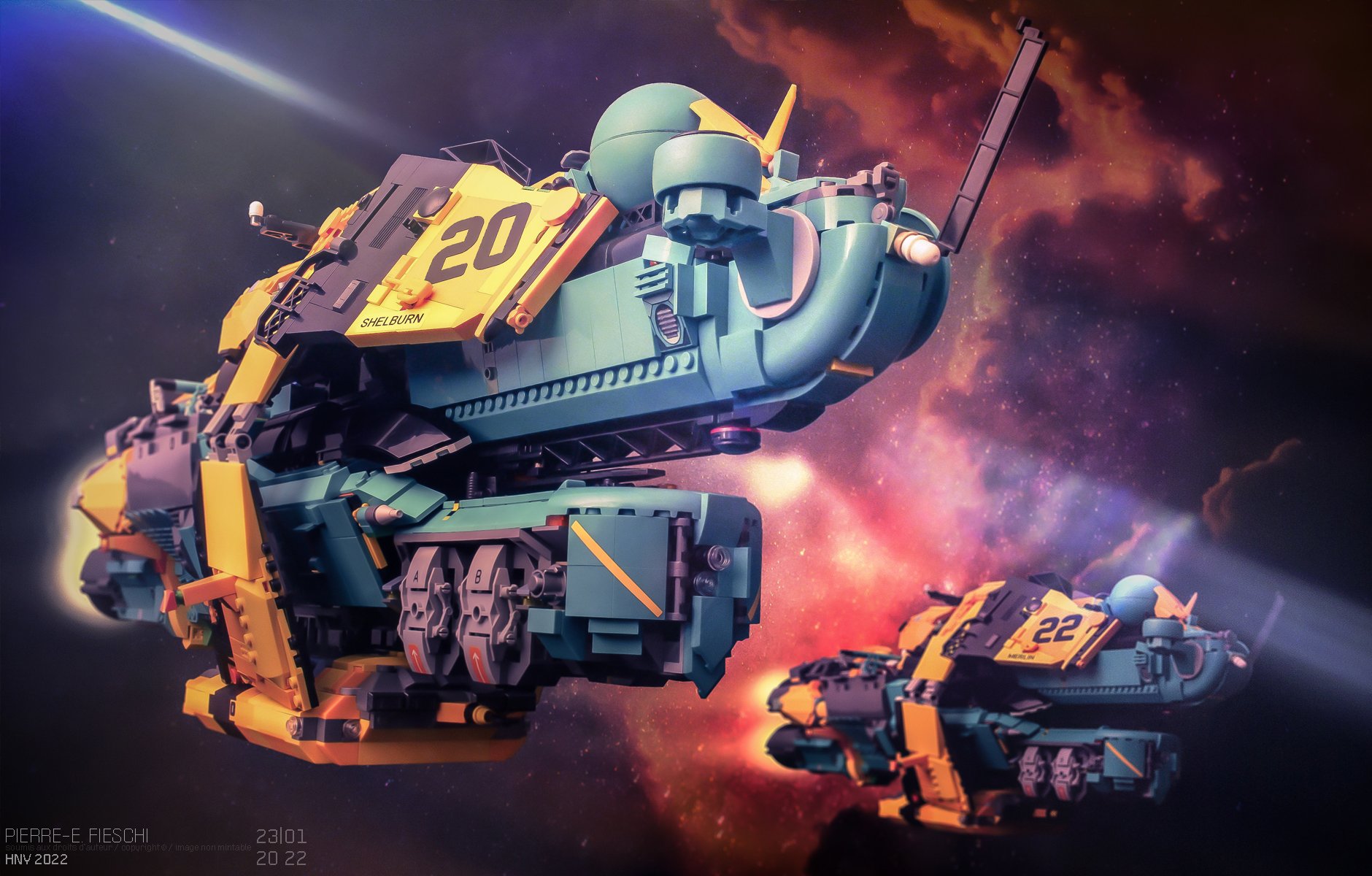
Oscar: And on that note, do you have any other tricks like that you’d like to share?
Pierre: One thing comes to mind: Don’t over-sort your bricks! It’s time-consuming, and some wonderfully fortunate combinations can happen inside your storage box with everything mixed up. When looking for a specific element for your build, you might stumble in the same drawer, onto something unexpected, more colorful, and more fun that may bring that extra spark of joy and NPU (nice parts usage) to your creation.
Oscar: Yes, I agree. I have piles of unsorted elements on my desk that sometimes help me with my builds. You seem to have a deep knowledge of the LEGO element library. Your MOCs are full of old and interesting parts from Fabuland and Modulex. How did you discover all those elements? Did you just have them laying around or is it the result of intense BrickLink-studies?
Pierre: I got Fabuland and older parts from my sister’s collection and tried to find second-hand LEGO when I could. As a result, I have some rather random strange and old parts. As soon as I discovered BrickLink I was able to be more methodical about this. I indeed dove into Modulex in an attempt to create details that go beyond the stud and break the perception of scale.
There is also the challenge of using bricks in a way that wasn’t planned and the joy of figuring out a combination that you’ve never seen before anywhere else.
Oscar: I totally agree and that is also part of my philosophy for building with LEGO. There are no bad or “useless” elements—you just need to find the right way to use them! Do you have a favorite LEGO element?
Pierre: That’s a very difficult question. I can definitely say my favorite LEGO color is teal, however a favorite element would be almost impossible to decide on!
Oscar: You’ve also used 3D-printed parts, clone brands and other random plastic parts in your builds. I guess this is a way for you to reach a specific shape. You don’t let the limited plethora of LEGO elements hinder your creative output. What are your thoughts about that?
Pierre: Yes, I was tempted to use clone brands at some point mostly for their sometimes juicy textured tiles and crazy slopes. I also looked at 3D printing and actually used it extensively on a few builds but mostly for color reasons rather than creating non-existing elements. However, ‘raw’ 3D printing is a slow and tedious process and doesn’t look great up close.
For the MAERSK Highliner Pierre created some custom bricks. Like a 2x4 “ingot” and some tiles with structure patterns.
Since then, LEGO released so many new great elements and colors that I don’t really feel the need to use clone brands or 3D printing anymore. I will still use random or custom stickers though, or an already broken or yellowed-out element if I think it looks good. In fact, I love using old yellowed bricks to give a paneling or weathering effect. As a result, I use my leftover clone brands and 3D printed stuff for kitbashing models which are not LEGO—glue, paint, kitbashing, etc.
These two “Armadillo” Land Carriers actually have a mostly clone brand structure, covered in other kitbash elements, scrap plastic and 3D printed elements.
Armadillo Land Carriers
I do like the idea of using recycled bits of scrap plastic as well when it is coherent with the build, like with the Clearskies corporation airship which is about ecology in an alternate timeline. Again this is something I feel I will be more inclined to do in a full kitbashing process in the future, rather than LEGO MOCs.
Clearskies Airship
Oscar: Does your love for LEGO influence the way you create your conceptual art and architecture? Do you think in LEGO elements when you draw your designs and buildings?
Pierre: Yes absolutely. I actually can’t really help thinking in LEGO elements outside of a creative process as well. Like “oh this is an interesting piece of sidewalk, I’d definitely use that brick on its side to replicate that geometry,” for example.
LEGO has become an artistic medium like any other for my projects and an interesting way to try and break down the things that surround me in the world. I also usually describe colors using the LEGO palette. As a result, I often use colors that actually look like LEGO colors in non-LEGO projects.
Oscar: I can definitely recognize that! I mostly see the world in LEGO elements and the LEGO color palette. I sometimes even get a bit baffled when I come upon a color that can’t be defined through LEGO colors! Moving along from that, can you tell me about one (or more) of the MOCs you are most proud of and why? What was the most challenging part of building it?
Pierre: It would have to be the Arc Hammer. That giant vehicle has a very strange aesthetic to it—its gantry is motorized by a power function remote control and it features a few LEGO lights and a rotating radar.
ARC Hammer
Also it is an absolutely flawed and unpractical design which is something I love to explore. (Once the cargo is lowered, the vehicle can no longer move, so it requires some opening doors below or another vehicle to help remove the cargo on the side, etc.) Humanity is an expert at making things overly complex, and while “form follows function” is an interesting theme, I believe sometimes the prime function is just to look a certain way or convey a certain emotion. The most challenging aspect of constructing it was making it sturdy and balanced enough with its massive overhang.
Oscar: I’m so glad you chose the ARC Hammer. It is actually THE build of yours that made me want to start building with LEGO!
The Creative Process
Oscar: So, now we’ve focused on your LEGO creations, let’s talk a bit about creativity in general. Prior to this interview, I asked you to read my article about creativity. Can you relate to any of my thoughts about creativity? What is your secret to conquering “builder’s block”? It seems like you must have methods for this, both with LEGO building and in your work.
Apex-V Mantis
Pierre: That was a very interesting read and I did relate to your own experience a lot. Builder’s block inevitably comes and goes and as you mentioned, setting things aside in a table scrap box is one of the best things to do when reaching a total lack of progress.
The Mantis Rover for example took years to build, with me working on it on and off with very slow progress. I have a few medium-sized scraps in the studio, some of which have been collecting dust for a decade.
Like with any creative discipline (music, painting, etc.), I personally think it may be beneficial to set things aside for a little while. Forcing things doesn’t work for me, and making MOCs is about relaxing and having fun. If you encounter builder’s block, maybe work on a MOC in a different scale or theme, and if you’re totally stuck, turn to another hobby for a while. The urge to browse through the unsorted bin always comes back!
Oscar: How do you kickstart your creativity and do you have any tricks for staying creative?
Pierre: Of course, there are countless movies, books and games to draw inspiration from, but I think it’s key to stay curious about the world. Look at things around you and try to figure out how they work, why they’re useful, why they’re unsymmetrical, why they’re colored in such or such a way, etc.
I also think being creative is intimately tied to having fun. What made you laugh or fascinated you as a kid? What themes bring you joy? Explore those sentiments and try to pinpoint what they’re about. Also writing down and sketching down ideas, even roughly, is always good. So I would advise you to always carry a notebook and a pencil just for that. Sometimes I’ll rediscover notes for ideas or sketches that have piled up over the years and that I remember nothing about, and it will trigger new ideas.
Oscar: Those are some great insights and ideas!
Game Design
Oscar: In the last couple of years you’ve had the opportunity to work with LEGO in a completely new way. You got tasked with designing big parts of a LEGO video game, Star Wars Castaways. Before we get into that, tell me a bit about what made you give up you career as an architect?
Pierre: I never really “gave up” on my career as an architect rather than it just somehow transformed into something else. While I was working in an architecture firms in Paris, I quickly specialized in rendering the 2D plans and elevations in Photoshop, jumping from project to project in the final stages. I never really worked on a single building for several years as architects would, but that suited me just fine as everything was always new and fresh. I later started doing 3D and renderings on top of the 2D work as well.
Oscar: Is that why and when you founded Renderstorm?
Pierre: Renderstorm was founded in that context by a happy coincidence of random events. In 2012, I received an email from Blackbird Interactive following the creation of my Homeworld-inspired LEGO spaceship “Tesseract”. Initially fearing I had done copyright infringement, it turned out they wanted to find ways to collaborate on what would later become Homeworld Deserts of Kharak.
Tesseract
In order to do so, I had to have my own company or studio, I thought. My contract with my architecture firm was ending at the same time and it was interesting for them and me to keep working together also with me as a freelancer. Development of Desert of Kharak (Shipbreakers at the time) got some delays and I ended up working with the architects for a while longer.
Oscar: So, how did you get to work with Gameloft on Star Wars Castaways?
Pierre: While Renderstorm was working mostly with architecture firms, I never gave up on the idea of working in the entertainment industry. When Gameloft contacted us (myself and my associate artist Coline) for a LEGO Star Wars project it was kind of a dream come true for both of us and we had to do everything to make it work, including shifting away from long-term partnerships with the architects, which was a bit heartbreaking and also very risky.
Castaways was released on Nov 19 2021 and is Available free with Apple Arcade. image via LEGO, Star Wars and Gameloft.
Oscar: Did you have any experience in game development prior to this?
Pierre: We had worked with game studios prior but never so extensively nor exclusively. We did have project experience from working with architects, autonomy, methodology and rigor which we could transpose to our tasks in this new field.
Oscar: Was that also maybe a way for you to be able to work with LEGO without moving to Denmark?
Pierre: Yes, we worked on Castaways full time for about two years, and had so many great opportunities, like visiting Billund with the Gameloft and Lucasfilm teams, meeting them again later in Montréal, not to mention countless meetings with the LEGO team during which we discussed a lot of aspects of development. We learned so much and the LEGO team was really awesome and passionate about the project.
image via LEGO, Star Wars and Gameloft.
Oscar: Tell us about the work you did on Star Wars Castaways.
Pierre: We can’t be grateful enough for all the things we were trusted with working on this title. We arrived very early on in preproduction which means the aesthetics of the game hadn’t been developed yet; which we helped with, and worked on countless topics until release; designing environments, vehicles and buildings, helping create LEGO-built UI, helping with creating some of the characters, images for the codex, and countless stickers and graphics, etc.
image via LEGO, Star Wars and Gameloft.
If I had to pick a favorite moment of mine it would be designing the underside of the Star Destroyer to scale with the UCS Tantive IV, from scratch with a very short five-day deadline.
image via LEGO, Star Wars and Gameloft.
Oscar: Did you have any opportunities to add some of your own designs into the game, and what was it like working with the Star Wars IP?
Pierre: While the Castaways story allowed us to look at the events in Star Wars in new and interesting ways, Lucasfilm is very protective of their IP, and understandably so. The game (free on Apple Arcade) is about revisiting past events in Star Wars but the location of Castaways itself was however entirely new. While we did create a few concepts for the game, most of the “new” stuff was done by concept artists and we worked mostly on translating these drawings into LEGO.
Another important part of our job was creating the modular assets that would be used by level designers. It was really fun exploring iconic themes such as the Death Star interior and exterior, the Tantive IV interior, Tatooine, or even Echo Base.
image via LEGO, Star Wars and Gameloft.
Oscar: It sounds like an amazing job! What aspects of the LEGO System did you want to convey through your designs for the game?
Pierre: The challenge was to create the entire game out of bricks, which had never been done with a game of such scale at the time. We wanted to create something that AFOLs would appreciate without breaking any of the rules that LEGO uses for making sets.
We also mostly had to create modular assets, which in essence became like bricks of their own, a system within the system, which was very interesting. Interestingly, modularity is a key aspect of design in a lot of games. LEGO is a great way to practice 3D projection and become familiar with the subject. It turns out the LEGO system way of thinking can be applied to non-LEGO games as well.
image via LEGO, Star Wars and Gameloft.
Oscar: What was it like working with Gameloft during the pandemic? I guess you couldn’t have any physical meetings?
Pierre: We had the chance to physically meet everyone before the pandemic started. I was used to working remotely, so the pandemic didn’t affect us as much as what we’ve seen happen around us. I would have enjoyed very much getting more opportunities to travel to Billund and Montréal. Maybe future projects will take us back there someday.
Conclusion
Oscar: I want to thank you for answering my questions and for being a huge source of inspiration for LEGO builders around the world. What advice would you give to anyone who wants to start building with LEGO? Or someone who wants to start drawing or work with game development for that matter?
Pierre: Whether you want to start building with LEGO, become an artist of some sort, or work in film or games, believe that it is possible. I was told repeatedly as a kid that those jobs didn’t exist, and while the entertainment industry wasn’t remotely as big as it is today, I wish I had known earlier that it was a possible career.
If however, like myself, you have studied something else entirely or have worked in a different field, use this unexpected element in your resume to your advantage. Just like that weird-looking section of your MOC we mentioned earlier, highlight it, frame it, make it look intentional. The entertainment industry is so varied and now requires so many different profiles that there may always be an opening.
And for those who want to build LEGO as a hobby, focus on just that. Build creations for yourself but share openly, forget trends, forget statistics and enter challenges for anything but the prize.
Oscar: Is there anything you wish you knew when you started building that you find useful now?
Pierre: Good photography and editing skills! They’re absolutely key to sharing your creations with the world. There are many fantastic tutorials for taking MOC pictures even if you don’t have an expensive camera and dedicated setup.
Oscar: Alright! We have a lot of articles about photography here on BrickNerd and if our readers would like to learn more about it I urge you to gem check them out! Again, a huge thanks for this chat, Pierre! Before we end, is there anything else that you would like to share with our BrickNerd readers?
Pierre: I want to thank such a wonderful community of LEGO builders, both online and IRL, for all the things I learned through them, all the fun challenges, all the failed WIPs, and jaw-dropping MOCs, all the nonsensical Febrovers, all the intense talks about a particular NPU or nice splash of color and most of all the endless flow of joyful creativity that is all too essential in life!
That concludes my interview with Pierre E. Fieschi. Did this interview give you any new ideas about MOCing? Is there something you would like to ask Pierre? Please let us know in the comments!
Do you want to help BrickNerd continue publishing articles like this one? Become a top patron like Charlie Stephens, Marc & Liz Puleo, Paige Mueller, Rob Klingberg from Brickstuff, John & Joshua Hanlon from Beyond the Brick, Megan Lum, Andy Price, John A. and Lukas Kurth from StoneWars to show your support, get early access, exclusive swag and more








